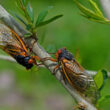Wichita, Kan.
By carefully selecting a site for Wichita, Kan.’s new sanitary sewer treatment plant, city officials have made way for a nature center and public wetland.
In 1987, the northwest part of Witchita was growing rapidly, which was taxing the city’s sanitary sewer collection system. To alleviate the problem, the city contemplated transporting sewage to the existing, large wastewater treatment plant in south central Wichita, which was approximately 15 miles away. However, officials recognized that laying interceptor lines through neighborhoods to transport sewage would incur substantial costs.
As an alternative, Wichita’s Water and Sewer Department (WWSD) decided to use local operations that would shorten sewage transport distances and reduce the load on the existing treatment plant. The city approved a sewer master plan to develop a treatment facility in the northwest that was “non-intrusive” to the environment.
Government officials faced significant local resistance to siting a wastewater treatment plant, says David Warren, the city’s director of water and sewer. “The public’s only reference was the south central facility that had been around a long time and had odor problems over the years. The general belief was that [a new facility] was going to be ugly and detract from property values.”
To allay concerns, officials conducted information fairs and sought the input of residents. Wichita eventually found a home for its treatment facility in a 148-acre area, which historical photographs and soil samplings indicated formerly was a wetland.
To show the community that a wastewater treatment facility could tastefully exist within its surroundings, the SSWD decided to add greenery and link the treatment facility to the sites’ wetlands history.
Today, the new sewage treatment facility and clean water holding pond use only 25 acres of the site. The remaining land is being used to reestablish the native prairie and the wooded Cowskin Creek corridor. The site currently houses 38 acres of constructed wetlands, 12 acres for public sport fishing and 12 acres of active public use areas with picnic areas, a group shelter, restrooms and recreational paths.
As a result of site restoration and wetland creation, which were completed last month, the city has:
-
restocked the riparian corridor (natural levee) with waterfowl, raptors, songbirds and mammals;
-
restored the abandoned channel area of the creek and shallow emergent depressions in the floodplain;
-
improved water quality; and
-
provided floodwater storage, detention and sediment removal and groundwater recharge.
-
Restoring the site and building the treatment plant cost the city $29.1 million, financed with the sale of revenue bonds. The payoff has been substantial, Warren says. The area now serves as an interpretive and recreational resource for the Wichita area, and it is an educational resource for local schools. The wastewater treatment facility and Cowskin Creek Nature Center and Public Wetland also is a “model for future Wichita wastewater treatment development,” he says.
“We’ve done a lot of talking and bragging about this facility, but it’s unlike anything else in this region of four to six states,” Warren says. “The governing body wanted to make this wastewater treatment facility a multi-functional facility that the community could be proud of.”
Agencies/companies involved: Brown & Caldwell, Denver; Dondlinger & Sons Construction, Wichita, Kan.; and Professional Engineering Consultants, Wichita, Kan.



















